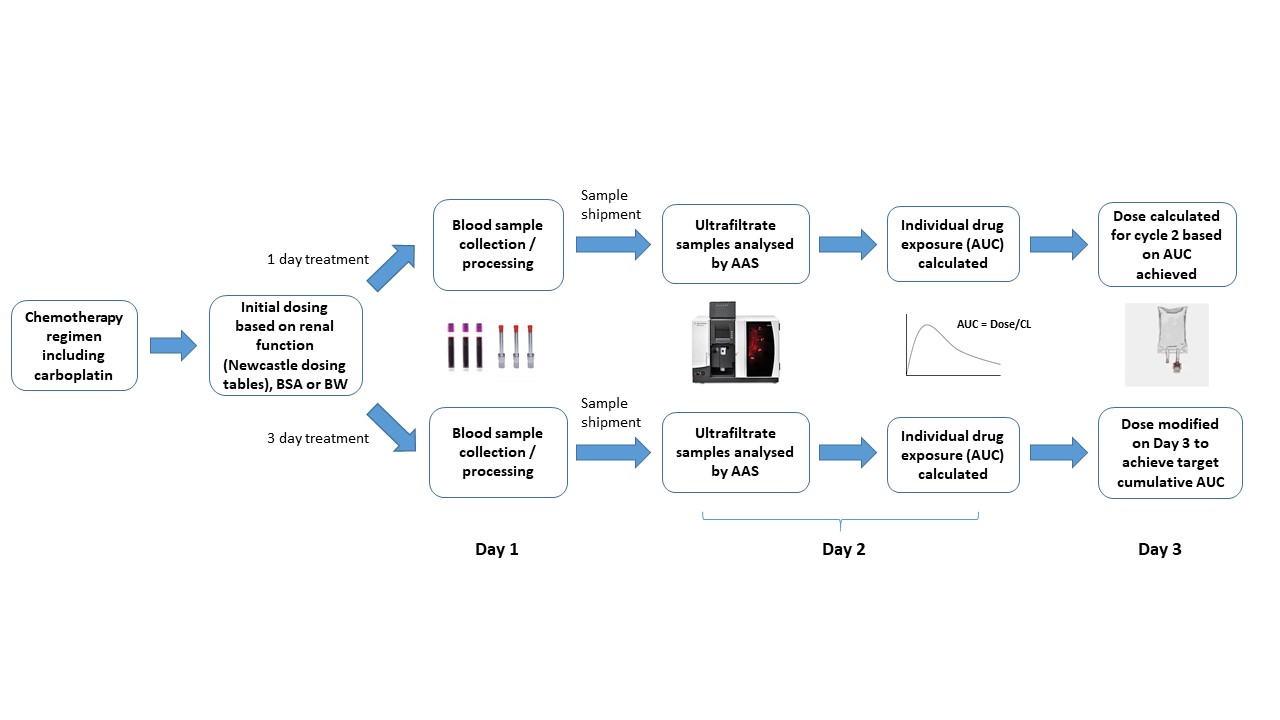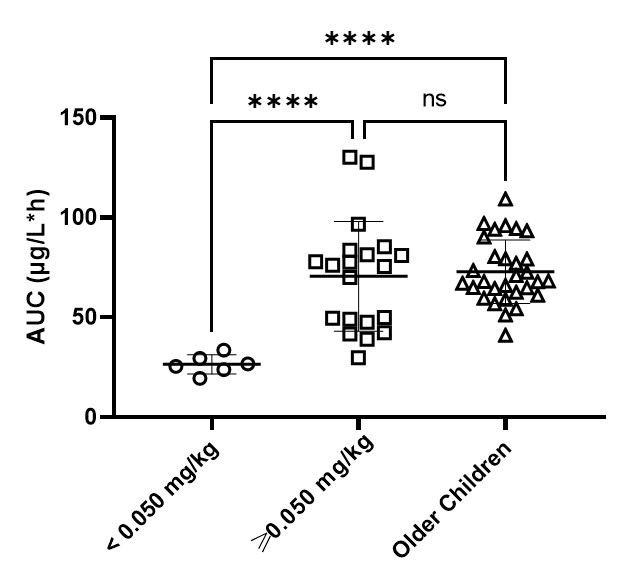| Author |
Method |
Number of Patients/Infants(<1yrs) |
Age(yr), Median(range) |
Age related findings |
|
Nguyen (2004)
|
One compartment popPK model
|
24 / 3
|
6.0 (0.45-16.7), mean (range)
|
A log-linear relationship between BW and CL was demonstrated with no further age-dependency. A novel dosing regimen (mg/kg dose adjusted to discrete weight categories) for a better AUC targeting was developed.
|
|
|
|
Booth (2007)
|
One compartment popPK model. Allometric scaling for BW.
|
24 / NS
|
6.3 (0.25-16.7), mean (range)
|
No effect of age on CL after adjusting for BW.
|
|
|
|
Bartelink (2012)
|
Two compartment popPK model. Allometric scaling for BW.
|
245 / NS
|
3.33 (0.1-26)
|
Non-linear relationship between BW and CL (L/h): An increase in BW in neonates results in a larger increase in CL than an increase in BW in older children or adults.
|
|
|
|
Bartelink (2012)
|
Two compartment popPK model. Allometric scaling for BW.
|
403 / NS
|
4.00 (0.1-35)
|
Non-linear relationship between BW and CL (L/h): An increase in BW in neonates results in a larger increase in CL than an increase in BW in older children or adults.
|
|
|
|
Michel (2012)
|
One compartment popPK model
|
67 / 9
|
4.0 resp. 7.5 (autoSCT resp. alloSCT) (0.3-17.2)
|
Non-linear relationship between BW and clearance.
|
|
|
|
Paci (2012)
|
One compartment popPK model. Allometric scaling for BW.
|
205 / NS
|
2.5 (0.03-15)
|
The higher allometric exponent for CL accounted for a larger increase of CL in children <9 kg. For infants <9 kg, the model predicted a 2.4-fold increase in CL for a doubling in BW, whereas a 1.7-fold increase in CL was associated for the same BW growth in children ≥9 kg.
|
|
|
|
Savic (2013)
|
One compartment popPK model. Allometric scaling for BW. CL corrected for maturation.
|
149 / NS (20 <0.5 yrs)
|
0.94 (0.08-3.3)
|
CL increases by approximately 1.7-fold between 6 weeks and 2 years of life due to maturation.
|
|
|
|
McCune (2014)
|
Two compartment popPK model. Allometric scaling for BW. CL corrected for maturation and sex. V1 and V2 corrected for sex
|
1610 / 256
|
9.8 (0.1-66), mean (range)
|
The maturation of CL reaches 50% of adult values at 6 weeks after birth assuming a full-term gestational age of 40 weeks. Size-standardized CL reaches 95% of adult values at 2.5 yrs.
|
|
|
|
Long-Boyle (2015)
|
One compartment popPK model. Allometric scaling for BW. CL corrected for maturation.
|
90 / NS
|
7 (0.1-24)
|
CL (adjusted for BW) increases up through 12 yrs and then begins to decline to adult levels.
|
|
|
|
Neely (2016)
|
One compartment popPK model. Allometric scaling for BW. CL and V corrected for age.
|
53 / NS
|
7.8 (0.2-19), mean (range)
|
CL (adjusted for BW) increases up through ~7 yrs and then begins to decline to adult levels.
|
|
|
|
Marsit (2020)
|
One compartment popPK model. Allometric scaling for BW. CL and V corrected for age.
|
136 / NS
|
6.6 (0.2-20.7), mean (range)
|
Age was included as covariates on all parameters.
|
|
|
|
Poinsignon (2020)
|
One compartment popPK model. Allometric scaling for BW. CL and V were corrected for maturation.
|
540 / 162
|
1.8 (0.02-24.1), mean (range)
|
All parameters were corrected for maturation.
|
|
|
|
Ben Hassine (2021)
|
Two compartment popPK model. Postmenstrual age dependent allometric scaling of BW on CL. CL corrected for day of therapy, GSTA1 diplotypes and regimen including fludarabine.
|
302 / NS
|
5.2 (0.1-20.1)
|
CL was corrected for maturation.
|
|
|
| Author |
Method |
Number of Patients/Infants(<1yrs) |
Age(yr), Median(range) |
Age related findings |
|
Tran (2004)
|
One compartment popPK model
|
20 / 1
|
5.5 (0.8-14.9)
|
CL (mL/min/kg) was higher in children <6 years than in patients >6 years.
|
|
|
|
Oechtering (2005)
|
One compartment popPK model
|
19 / 1
|
4 (0.9-17.3)
|
No effect of age on exposure.
|
|
|
|
Zwaveling (2006)
|
One compartment PK model
|
18 / 1
|
7.0 (0.5-16)
|
CL (L/h/kg) proved to be dependent on age, whereas CL (L/h/m2) was age-independent.
|
|
|
|
Schechter (2007)
|
One compartment popPK model
|
45 / 13
|
3.0 (0.25-16.2)
|
CL (mL/min/kg) was significantly higher in children <4 yrs. However, CL (mL/min/m2) was significantly lower in children <1 yrs and <4 yrs. V (L/kg) was significantly higher in children <1 year or <4 years.
|
|
|
|
Nath (2008)
|
One compartment PK model
|
40 / 7
|
3.2 (1.5-9.1)
|
Age correlated with CL (L/h) and CL (L/h/kg), but not with CL (L/h/m2). AUC did not correlate with age.
|
|
|
|
Trame (2011)
|
One compartment popPK model. Allometric scaling for BW.
|
94 / NS
|
9.2 (0.4-18.8)
|
Effect of age was not described.
|
|
|
|
Veal (2012)
|
One compartment popPK model. Allometric scaling for BW.
|
38 / NS
|
3.6 (0.7-13.1), mean (range) for iv subgroup
|
Effect of age was not described.
|
|
|
|
McCune (2013)
|
Non-compartmental pharmacokinetics, one or two compartment PK model. Allometric scaling for BW.
|
729 / NS
|
5.0 (0.1-20.0)
|
Non-linear relationship between age and CL (mL/min/kg).
|
|
|
|
Diestelhorst (2014)
|
One compartment popPK model. Allometric scaling for BW.
|
82 / NS
|
NS (0.4-18.8)
|
Effect of age was not described.
|
|
|
|
Okamoto (2014)
|
One compartment popPK model. BW was included as covariate on CL and V.
|
25 / 5
|
6 (0.4-17)
|
Effect of age was not described.
|
|
|
|
Nava (2018)
|
One compartment popPK model. Allometric scaling for BW. CL corrected for maturation and GSTA1 diplotypes
|
112 / 20
|
5.4 (0.1-20)
|
CL was corrected for maturation.
|
|
|
|
Alsultan (2020)
|
One compartment popPK model. Allometric scaling for BW.
|
59 / NS
|
6.1 (0.16-13), mean (range)
|
Effect of age was not described.
|
|
|
|
Yuan (2021)
|
One compartment popPK model. CL corrected for BSA, GSTA1 diplotypes and ASAT. V corrected for BSA.
|
69 / NS
|
4.90 (0.50-15.18)
|
No effect of age after including BSA as covariate.
|
|
|
| Author |
Method |
Number of Patients/Infants(<1yrs) |
Age(yr), Median(range) |
Age related findings |
|
Dalle (2003)
|
Non-compartmental pharmacokinetics
|
14 / 14
|
0.4 (0.06-1)
|
Cumulative dose of 16 mg/kg leads to increased exposure in infants compared to adults. No correlation between age and AUC in the complete cohort. A trend for correlation between age and AUC in the female subgroup was seen.
|
|
|
|
Kletzel (2006)
|
Non-compartmental pharmacokinetics
|
30 / 8
|
8 (0.11-16)
|
Effect of age was not studied.
|
|
|
|
Kim (2009)
|
Non-compartmental pharmacokinetics
|
21 / NS
|
8 (0.25-18), mean (range)
|
CL (mL/min/kg) was significantly higher in children <4 yrs.
|
|
|
|
Wall (2009)
|
Non-compartmental pharmacokinetics
|
24 / 3
|
3.3 (0.5-16.7)
|
No effect of age on CL (mL/min/kg).
|
|
|
|
Le Gall (2013)
|
Non-compartmental pharmacokinetics
|
49 / 3
|
7.4 (0.2-18.4), mean (range)
|
CL (mL/min/kg) was significantly higher in children <4 yrs.
|
|
|
|
Neroutsos (2021)
|
Non-compartmental pharmacokinetics
|
76 / NS (12 <2 years)
|
6.5 (0.5-19)
|
Effect of age was not studied.
|
|
|


